4th (2001)
 "Whispering Sands" |
 "Journey of the Gray Men" |
 "The Road" |
 "The Best of Times" |

Whispering Sands
2001 / Indonesia=NHK / Color / 110min.
*2001 Pusan International Film Festival New Currents
*2001 Asia-Pacific Film Festival Best Cinematography Award Best Sound Award Jury's Special Award for Most Promising Director
*2001 Asia-Pacific Film Festival Best Cinematography Award Best Sound Award Jury's Special Award for Most Promising Director
[SYNOPSIS]
The film is set in a seashore village around 1960. Berlian lives with her daughter, Daya, in a simple house. Her husband, Agus, is an itinerant peddler, and sells medicine by using a puppet to lure customers. He has been away since Daya was small, so all she remembers is an image of her father working a puppet. Berlian helps a midwife with deliveries and abortions, and also sells medicines.
One day, Delima, Berlian's sister, visits them. She is a traveling dancer. Delima tries to persuade Berlian to leave the village, as the rebellious troops are advancing, and it is becoming dangerous to remain there, but Berlian insists on staying. However, as their house is set on fire, they escape from the village.
After wandering around in the sands, trying to make their way to Pasir Putih, Berlian and Daya finally arrive at a hovel. Berlian starts selling medicine in a sand-swept hut and Daya befriends Sukma, a physically handicapped girl with a beautiful voice. Sukma has no parents, and lives with her aging grandfather.
One day, Delima arrives there with her troupe, and gives Daya a lovely red traditional costume. Berlian will not allow her daughter to go and watch their dance, but Daya secretly goes out to enjoy the show all night long. When she returns home the following morning, she comes across her mother burning her red costume. Daya blames her mother hysterically of taking away everything she likes, including her father. However, Agus visits their hovel unexpectedly, and begs them to let him stay. Agus tells Daya about city life and its opportunities, and that he promises to buy her and her mother anything and everything they want when he becomes successful.
Daya is playing with Skuma. Then, the rebellious troops burst in. After the troops leave, Skuma is left dead. Daya presses her ear to the sand, and tries to listen to Skuma's voice, which has disappeared into the ground.
Agus asks his lamenting daughter out for a walk, and takes her to a moneylender and talks over something with him. Then one day, Agus takes Daya to the moneylender again. To her shock, the moneylender asks Daya to masturbate in front of him...
On seeing Daya collapse on the sand, suffering a sense of dejection, Berlian suspects everything. She then prepares special medicine, and her husband takes it. Agus collapses. Next morning, the hut is buried under the sand. Agus is buried alive. The moneylender's house is burnt down. Daya tries to listen to the voices from below ground, standing at a place which has turned into a mere sand mound.
_On the outskirts of the village. Berlian leaves Daya with Skuma's grandfather, and asks them to leave. A mother and a child cry, throwing themselves at each other, but Berlian is determined not to change her decision. After sending her daughter away, Berlian stands there alone, sorrow-stricken.
Teary Grains of Sand / Mayumi Kataoka (Writer, Editor)
The story is about Daya, an innocent girl who cannot even do her own hair, and her mother, who makes a living by selling medical herbs. They live in a sand-swept village in the shadows. The daughter yearns for her absent father and is curious about the world outside her village. The mother watches over her growing daughter with dignity despite their hard life. Although they are deeply bonded by love, they begin to drift apart little by little. As the mother realizes that not far in the future Daya has to leave home to live on her own, she struggles not to express her worries and insecurities to her naive daughter. Daya has no clue about what goes on in her mother's mind, and is impatient just to enjoy herself right now.
The film depicts women, who live gallantly in spite of their hardship. It also captures superb, but unconscious nature, like a scene from a myth that is full of stunningly beautiful images; the drifting sands, and the field in which Daya and Skuma, her friend, play about. The seaside that stages a dance procession. The starkly beautiful, but bleak land that is like a fleeting mirage.
On the other hand, men in this world wander about without intensions to settle down. When Daya and her mother leave their village behind just before it was set on fire, they encounter a man who kindly offers them some food. In contrast to their tension, he walks away carefree. A man who gives Daya a charm mask runs away, stealing their food without any disquieting or mixed emotions. Then, Daya's father visits them out of blue. He is also wandering about alone, without facing reality. He ends up betraying Daya and her mother mercilessly. For the mother who has experienced countless hardships, life is like a constant piercing pain caused by the sands that keep blowing against her. To protect her daughter from such harsh grains of sand, she wants her daughter to be educated, and to keep her away from becoming a 'mature woman'. Daya however wants her mother to call her by her name and to treat her as an individual, not just her 'daughter'.
However, what her father tells Daya to do to show her love for him leaves Daya completely emotionally devastated. Though she perhaps does not totally comprehend what the action means, at least she immediately suspects that she is perceived as a 'woman', an object of men's desire. That is what her mother has been afraid of. The mother must have wanted to keep her daughter beside her forever. Daya is her only cherished treasure. She would not want to leave her. On the other hand, she is aware that there is no future for her daughter as long as Daya stays with her. She thus leaves Daya with an old man to begin a journey for her daughter's sake, biting back her bitter anguish of being alone.
Sands sweep and carry away her tears, as if it were nothing.
Women are at the mercy of their environments, like a flux of sands perpetually transfigured by constant wind. Drifty sands listen and respond to the sense of suffering expressed by the women, but at the same time wipe it out. Such reality is not limited to women living in a specific environment in Indonesia alone, but overlaps with the voice of a great many women and the universality of deep motherly love and sufferings.
The film is set in a seashore village around 1960. Berlian lives with her daughter, Daya, in a simple house. Her husband, Agus, is an itinerant peddler, and sells medicine by using a puppet to lure customers. He has been away since Daya was small, so all she remembers is an image of her father working a puppet. Berlian helps a midwife with deliveries and abortions, and also sells medicines.
One day, Delima, Berlian's sister, visits them. She is a traveling dancer. Delima tries to persuade Berlian to leave the village, as the rebellious troops are advancing, and it is becoming dangerous to remain there, but Berlian insists on staying. However, as their house is set on fire, they escape from the village.
After wandering around in the sands, trying to make their way to Pasir Putih, Berlian and Daya finally arrive at a hovel. Berlian starts selling medicine in a sand-swept hut and Daya befriends Sukma, a physically handicapped girl with a beautiful voice. Sukma has no parents, and lives with her aging grandfather.
One day, Delima arrives there with her troupe, and gives Daya a lovely red traditional costume. Berlian will not allow her daughter to go and watch their dance, but Daya secretly goes out to enjoy the show all night long. When she returns home the following morning, she comes across her mother burning her red costume. Daya blames her mother hysterically of taking away everything she likes, including her father. However, Agus visits their hovel unexpectedly, and begs them to let him stay. Agus tells Daya about city life and its opportunities, and that he promises to buy her and her mother anything and everything they want when he becomes successful.
Daya is playing with Skuma. Then, the rebellious troops burst in. After the troops leave, Skuma is left dead. Daya presses her ear to the sand, and tries to listen to Skuma's voice, which has disappeared into the ground.
Agus asks his lamenting daughter out for a walk, and takes her to a moneylender and talks over something with him. Then one day, Agus takes Daya to the moneylender again. To her shock, the moneylender asks Daya to masturbate in front of him...
On seeing Daya collapse on the sand, suffering a sense of dejection, Berlian suspects everything. She then prepares special medicine, and her husband takes it. Agus collapses. Next morning, the hut is buried under the sand. Agus is buried alive. The moneylender's house is burnt down. Daya tries to listen to the voices from below ground, standing at a place which has turned into a mere sand mound.
_On the outskirts of the village. Berlian leaves Daya with Skuma's grandfather, and asks them to leave. A mother and a child cry, throwing themselves at each other, but Berlian is determined not to change her decision. After sending her daughter away, Berlian stands there alone, sorrow-stricken.
Teary Grains of Sand / Mayumi Kataoka (Writer, Editor)
The story is about Daya, an innocent girl who cannot even do her own hair, and her mother, who makes a living by selling medical herbs. They live in a sand-swept village in the shadows. The daughter yearns for her absent father and is curious about the world outside her village. The mother watches over her growing daughter with dignity despite their hard life. Although they are deeply bonded by love, they begin to drift apart little by little. As the mother realizes that not far in the future Daya has to leave home to live on her own, she struggles not to express her worries and insecurities to her naive daughter. Daya has no clue about what goes on in her mother's mind, and is impatient just to enjoy herself right now.
The film depicts women, who live gallantly in spite of their hardship. It also captures superb, but unconscious nature, like a scene from a myth that is full of stunningly beautiful images; the drifting sands, and the field in which Daya and Skuma, her friend, play about. The seaside that stages a dance procession. The starkly beautiful, but bleak land that is like a fleeting mirage.
On the other hand, men in this world wander about without intensions to settle down. When Daya and her mother leave their village behind just before it was set on fire, they encounter a man who kindly offers them some food. In contrast to their tension, he walks away carefree. A man who gives Daya a charm mask runs away, stealing their food without any disquieting or mixed emotions. Then, Daya's father visits them out of blue. He is also wandering about alone, without facing reality. He ends up betraying Daya and her mother mercilessly. For the mother who has experienced countless hardships, life is like a constant piercing pain caused by the sands that keep blowing against her. To protect her daughter from such harsh grains of sand, she wants her daughter to be educated, and to keep her away from becoming a 'mature woman'. Daya however wants her mother to call her by her name and to treat her as an individual, not just her 'daughter'.
However, what her father tells Daya to do to show her love for him leaves Daya completely emotionally devastated. Though she perhaps does not totally comprehend what the action means, at least she immediately suspects that she is perceived as a 'woman', an object of men's desire. That is what her mother has been afraid of. The mother must have wanted to keep her daughter beside her forever. Daya is her only cherished treasure. She would not want to leave her. On the other hand, she is aware that there is no future for her daughter as long as Daya stays with her. She thus leaves Daya with an old man to begin a journey for her daughter's sake, biting back her bitter anguish of being alone.
Sands sweep and carry away her tears, as if it were nothing.
Women are at the mercy of their environments, like a flux of sands perpetually transfigured by constant wind. Drifty sands listen and respond to the sense of suffering expressed by the women, but at the same time wipe it out. Such reality is not limited to women living in a specific environment in Indonesia alone, but overlaps with the voice of a great many women and the universality of deep motherly love and sufferings.
[DIRECTOR]
Nan Achnas
Nan Achnas studied film directing at the Jakarta Institute of the Art. Her diploma film, "The Only Day" received the Grand Prix Award at the ASEAN Young Cinema Film Festival in 1992. Recipient of the British Chevening Fellowship, Nan was given the opportunity to take her Master of Art in Film Studies at the University of East Anglia. She has been working as writer-director for a variety of short films, documentaries, teleplays, and commercials. She also teaches at film school. Her documentary, "Little Gayo Singer (Ceh Kucak Gayo / 1995)" was screened at Yamagata International Film Festival in 1997. In 1998, four directors, Mira lesmana, Riri Riz, Rizal Mantovani, and she co-directed omnibus film, "Kuldesak". "Whispering Sands" is her first feature film she directed.
[STAFF]
Director / Original Story : Nan Triveni Achnas
Screenplay : Nan Triveni Achnas, Rayya Makarim
Executive Producer : Shanty Harmayn,Ueda Makoto (NHK ENTERPRISES 21, INC), Christine Hakim, Harris Lasmana
Producer : Shanty Harmayn, Desiree Harahap
Director of Photography : Yadi Sugandhi
Music : Thoersi Argeswara
Sound Designer : Phil Judd
Art Director : Frans X.R Paat
Editor : Sentot Sahid
[CAST]
Berlian : Christine Hakim
Agus : Slamet Rahardjo Djarot
Daya : Dian Sastrowardoyo
Suwito : Didi Petet
Delima : Karlina Inawati
Bidan Suri : Dewi Sawitri
Sukma : Dessy Fitri
Kakek : Drs. Purnomo [Mang Udel]
Pemberontak : dik Doank
Japanese Subtitles : Sakiko Nishihiro
[DIRECTOR'S STATEMENT]
The story germinated about five years ago when I was shooting a documentary about Mount Bromo in East Java. The location with its magnificent desert landscape, the truly beautiful sunsets, and the mists that settle and vanish throughout the day was in short extremely inspiring.
The characters - Berlian, Daya, Agus, Suwito - are an amalgamation of many characters that I have met, read about and imagined. Berlian, particularly, is a based on a woman who sat with her daughter facing me in a bus ride when I was still a film student in Jakarta. This woman held her daughter's hand tightly and sat on the only seats available, the ones that face the rest of the passengers. Her daughter's face was badly scarred by burn marks, she was bald and had no earlobes. The woman removed a handkerchief out of her sleeve and held it before the little girl's face for about 45 minutes without any support.
It was this kind of unconditional love, strength and endurance that I wanted to portray in the character named Berlian. Her love towards Daya becomes an obsessive one afraid that her daughter would turn out to be like her. Bitter due to unrealized dreams.
It is not only a story about how a mother's love can both stifle and liberate a person's spirit but it is also about power and the decisions people make in life that sometimes have little to do with the accepted norms in society.
Nan Achnas
Nan Achnas studied film directing at the Jakarta Institute of the Art. Her diploma film, "The Only Day" received the Grand Prix Award at the ASEAN Young Cinema Film Festival in 1992. Recipient of the British Chevening Fellowship, Nan was given the opportunity to take her Master of Art in Film Studies at the University of East Anglia. She has been working as writer-director for a variety of short films, documentaries, teleplays, and commercials. She also teaches at film school. Her documentary, "Little Gayo Singer (Ceh Kucak Gayo / 1995)" was screened at Yamagata International Film Festival in 1997. In 1998, four directors, Mira lesmana, Riri Riz, Rizal Mantovani, and she co-directed omnibus film, "Kuldesak". "Whispering Sands" is her first feature film she directed.
[STAFF]
Director / Original Story : Nan Triveni Achnas
Screenplay : Nan Triveni Achnas, Rayya Makarim
Executive Producer : Shanty Harmayn,Ueda Makoto (NHK ENTERPRISES 21, INC), Christine Hakim, Harris Lasmana
Producer : Shanty Harmayn, Desiree Harahap
Director of Photography : Yadi Sugandhi
Music : Thoersi Argeswara
Sound Designer : Phil Judd
Art Director : Frans X.R Paat
Editor : Sentot Sahid
[CAST]
Berlian : Christine Hakim
Agus : Slamet Rahardjo Djarot
Daya : Dian Sastrowardoyo
Suwito : Didi Petet
Delima : Karlina Inawati
Bidan Suri : Dewi Sawitri
Sukma : Dessy Fitri
Kakek : Drs. Purnomo [Mang Udel]
Pemberontak : dik Doank
Japanese Subtitles : Sakiko Nishihiro
[DIRECTOR'S STATEMENT]
The story germinated about five years ago when I was shooting a documentary about Mount Bromo in East Java. The location with its magnificent desert landscape, the truly beautiful sunsets, and the mists that settle and vanish throughout the day was in short extremely inspiring.
The characters - Berlian, Daya, Agus, Suwito - are an amalgamation of many characters that I have met, read about and imagined. Berlian, particularly, is a based on a woman who sat with her daughter facing me in a bus ride when I was still a film student in Jakarta. This woman held her daughter's hand tightly and sat on the only seats available, the ones that face the rest of the passengers. Her daughter's face was badly scarred by burn marks, she was bald and had no earlobes. The woman removed a handkerchief out of her sleeve and held it before the little girl's face for about 45 minutes without any support.
It was this kind of unconditional love, strength and endurance that I wanted to portray in the character named Berlian. Her love towards Daya becomes an obsessive one afraid that her daughter would turn out to be like her. Bitter due to unrealized dreams.
It is not only a story about how a mother's love can both stifle and liberate a person's spirit but it is also about power and the decisions people make in life that sometimes have little to do with the accepted norms in society.



